

CCAFS: CGIAR research program on Climate Change, Agriculture and Food Security. Take Your Tiny House Off The Grid! By LaMar Alexander If you are considering a tiny house lifestyle I would also like to encourage you to consider taking your tiny house off the grid.
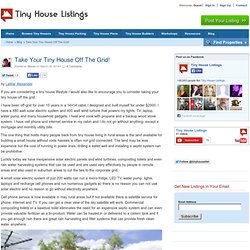
I have been off-grid for over 15 years in a 14×14 cabin I designed and built myself for under $2000. H2Oscore. The Edible Schoolyard Project. Social Investments. Permaculture–Regenerative Design Institute–Northern California–Permaculture Certification, Leadership & Nature Awareness. Industrial Hemp Fiber Processors and Distributors l NC. Rural-Urban Partnerships - Books. EPEAT. Reduce carbon footprint with carbon offsets. Securing Water For Food. Regenesis Group [ creating health and evolution for ecosystems and communities ] Sustainable and Resilient Communities Webinar (recorded) A Conceptual Guide to Employee Ownership for Very Small Businesses. Home » Articles » For companies with fewer than 20 employees who will stay that size, who do not plan to go public, and who do not want or cannot do an ESOP Many smaller companies want to share ownership with employees but find the legal costs and complexities of various common plans daunting.
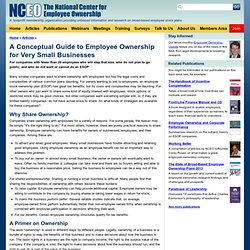
For owners wanting to sell to employees, an employee stock ownership plan (ESOP) has great tax benefits, but its costs and complexities may be daunting. For other owners who just want to share some kind of equity interest with employees, stock options or restricted stock may be good choices, but other companies want something simpler still, or, if they are limited liability companies, do not have actual stock to share.
So what kinds of strategies are available for these companies? Why Share Ownership? Companies share ownership with employees for a variety of reasons. A Primer on Ownership The word "ownership" is used in different ways by different people. Ownership in Partnerships. Cold Seawater Air Conditioning. SeaWater Air Conditioning (SWAC) takes advantage of available deep cold seawater to replace energy-intensive central refrigeration systems that cool chilled water to provide air conditioning in one or more buildings.
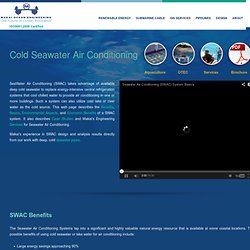
Such a system can also utilize cold lake or river water as the cold source. This web page describes the Benefits, Basics, Environmental Aspects, and Economic Benefits of a SWAC system. It also describes Case Studies and Makai’s Engineering Services for Seawater Air Conditioning. Makai’s experience in SWAC design and analysis results directly from our work with deep, cold seawater pipes. SWAC Benefits The Seawater Air Conditioning Systems tap into a significant and highly valuable natural energy resource that is available at some coastal locations. SWAC Basics A seawater air conditioning system is illustrated to the right. The seawater intake pipeline brings in water at a temperature lower than the temperature maintained in the chilled water loop. Environmental Aspects. HeartQuotes™: Clarity. More Than A Beautiful Home. A place of inspiration and information to help you live better in your home Welcome to More Than A Beautiful Home where we blend the art of home and the science of better to help you get more from your home without sacrificing beauty.
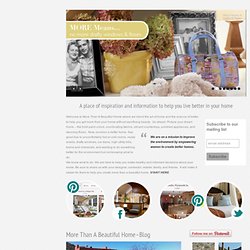
Go ahead. Picture your dream home – the bold paint colors, coordinating fabrics, vibrant countertops, polished appliances, and stunning floors.We are on a mission to improve the environment by empowering women to create better homes. RecycleStore Home Page: Innovative Green Products Made of Recycled Materials Made in the USA. Product Details: RecycleStore. OL 440 Diploma Integrated DRR, CBA & Development - CSDi. Courses are offered every two months.
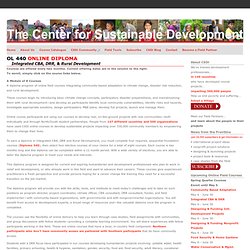
Current offering dates are in the column to the right.To enroll, simply click on the course links below. A Module of 8 CoursesA diploma program of online field courses integrating community-based adaptation to climate change, disaster risk reduction, and rural development. These courses begin by introducing basic climate change concepts, participatory disaster preparedness, and mainstreaming them with rural development—and develop as participants identify local community vulnerabilities, identify risks and hazards, investigate appropriate solutions, design participatory M&E plans, develop full projects, launch and manage them.
Online course participants are using our courses to develop real, on-the-ground projects with real communities—both individually and through North/South student partnerships. Students with a CBA or traditional rural development focus have utilized project activities addressing over 270 different types of challenges. STEP 1. Online Course to Design Projects From the GroundUp - CSDi. OL 101 comes in two tracks: Northern Nonprofit and International Development.

The Challenge Although many NGOs are working to reach the UN’s Millennium Development Goals by 2015, we still have over 1 billion people suffering from hunger, a lack of safe drinking water, and extreme poverty. An important underlying cause of these challenges is that development effectiveness can be limited by in-country field staff’s poor access to mission-critical information and training. Development Crossing - Corporate Social Responsibility (CSR) and Sustainability. 2030 Palette ©2011 2030, Inc. / Architecture 2030. The 2030 Palette is a free online platform that puts the principles and actions behind low-carbon and resilient built environments at the fingertips of design professionals worldwide.

Since planning and designing the built environment is primarily a visual activity, the 2030 Palette is structured as a visual network of interrelated elements called Swatches. Swatches present highly complex and multi-dimensional information in a readily accessible format organized by category – Region, City/Town, District, Site and Building. Each Swatch contains a written recommendation, rule-of-thumb, images and graphics representing the physical application of the recommendation, as well as more detailed information for its successful application.
Region addresses built and natural environments surrounding cities and towns. Swatches at this scale consider large planning issues such as land use, settlement areas, natural habitat vitality and viability, and transit network. Copenhagen Fingerplan 2007. Architecture 2030. 2030 Palette ©2011 2030, Inc. / Architecture 2030.